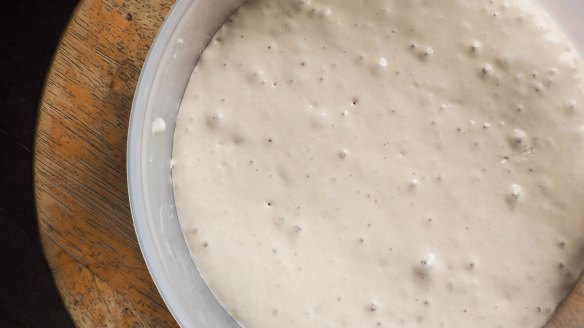How to get started on sourdough breadmaking

I want to make my own bread. The recipe calls for sourdough starter. Is it available in supermarkets? Or does a person have to go and beg for it? R. Yates.
Don't move. It's on you. Everywhere. Crawling on your skin. It's on the kitchen bench. In the trees in the garden. The air you breath. It's everywhere. We're talking a whole lot of microscopic bugs that work as a team to make your sourdough bread rise. There are yeasts, lactobacilli and acetobacters. They are all naturally occurring and invisible. You can capture them by placing a trap – a lump of dough made from flour and water – and leaving it in the open. This will soon become home to natural yeasts. They break down the starch into simple sugars and ferment some of these sugars to produce carbon dioxide, alcohol, heat and water. Acetobacters turn alcohol into acetic acid. There's the tang of a sourdough right there. Lactobacilli turn sugars into lactic acid. They break down starch, protein and peptides, making the grains more nutritious to us. Research shows that properly fermented sourdough bread is more easily digested than yeast-only fermented bread, even among those who normally cannot digest grains. The starter is also called a sourdough mother, levain or biga and is a living thing, a gooey dough that needs feeding regularly with flour and water and needs to be divided otherwise it would simply get too big. The process is relatively simple but does require some explaining. You'll find recipes in good baking books such as Dan Lepard's The Handmade Loaf or Phillippa's Home Baking by Phillippa Grogan and yours truly, or you can search for one online.
How can I make cordial from the fruit of my chinotto tree? R. Starr
I just had a mental image of a tree covered in pendulous little bottles. Sorry. You, of course, have a type of orange tree called a chinotto, Citrus myrtifolia, after which the Italian soft drink is named. You can make cordial by taking 10 ripe fruit, rolling them under the palm of your hand to release the juice inside the fruit. Zest half the oranges, juice them all, and combine the zest, juice, 500ml of water and 650g sugar in a non-reactive pan and bring to the boil. Allow to cool a little then strain into two sterilised 500ml bottles. Seal. These will keep for four months. Dilute with one part of cordial to four parts of sparkling water and serve on ice, perhaps with a shot of vodka or even limoncello. Cin cin.
Correspondence
On the question of salad leaves, readers have pointed out there is the soft-leafed rocket, which is an annual, Eruca sativa, and another perennial with narrower leaves, Diplotaxis tenuifolia, that loves growing in cracks in rocks and is sometimes called wall rocket or wild rocket. It is also a member of the cabbage family.
Send your vexing culinary conundrums to brainfood@richardcornish.com.au or tweet to @Realbrainfood.
Appears in these collections
More:
From our partners
Original URL: https://www.smh.com.au/goodfood/how-to-get-started-on-sourdough-breadmaking-20180801-h13fpp.html
